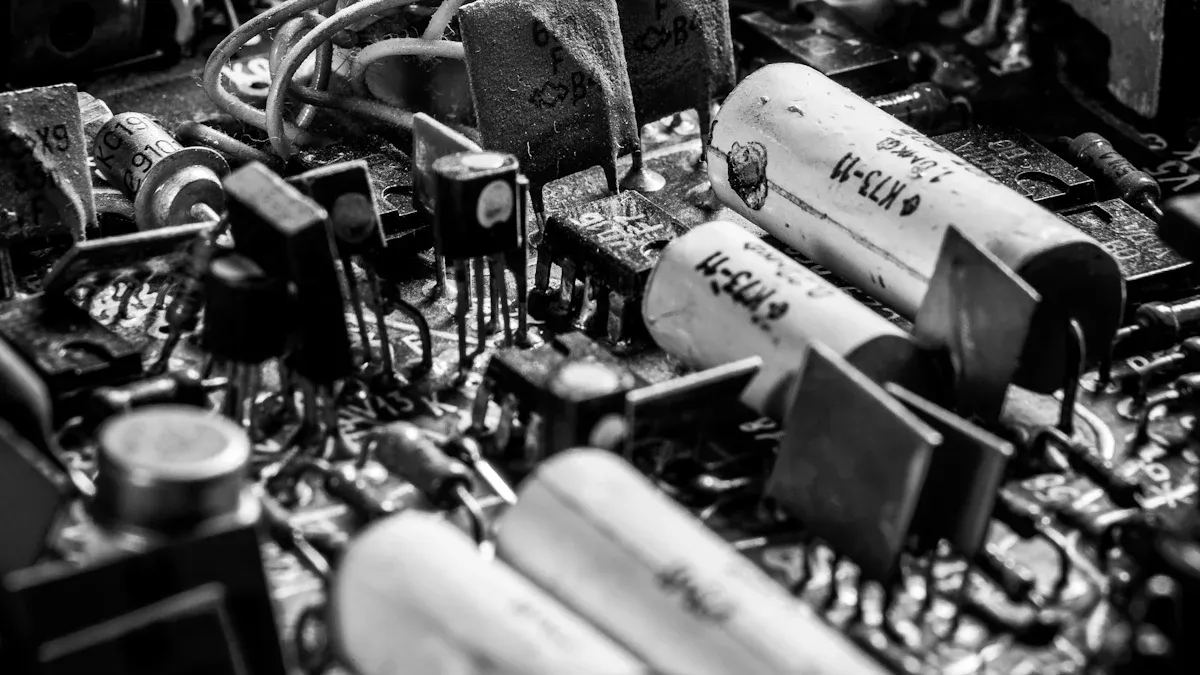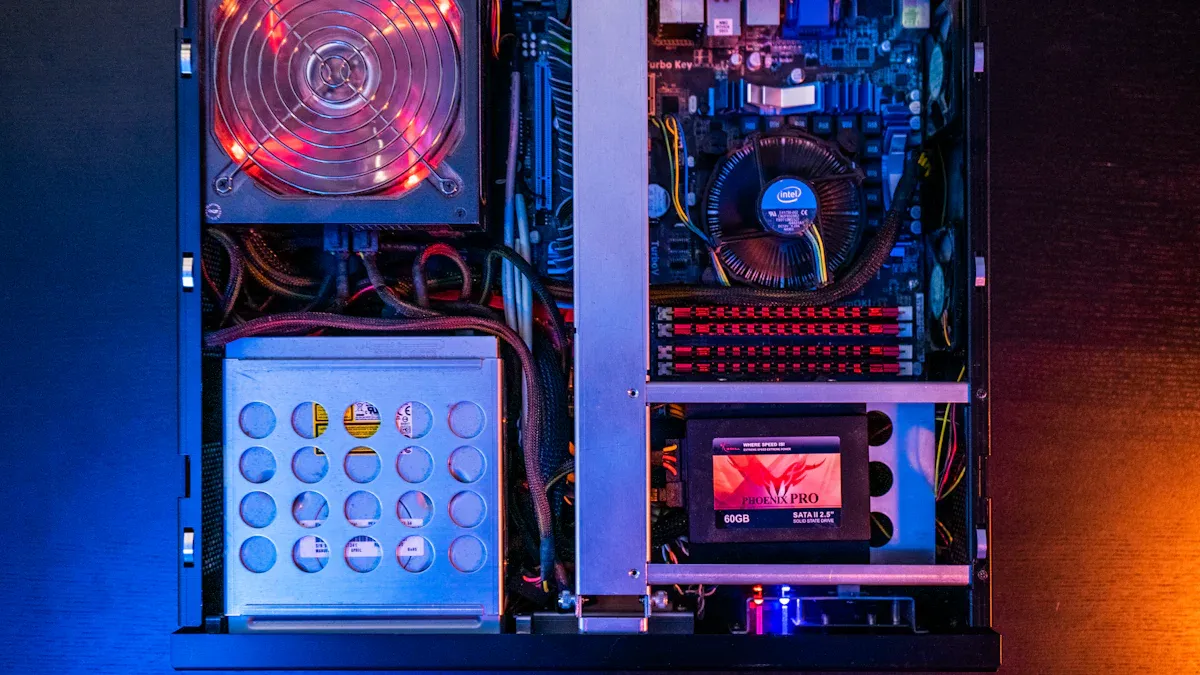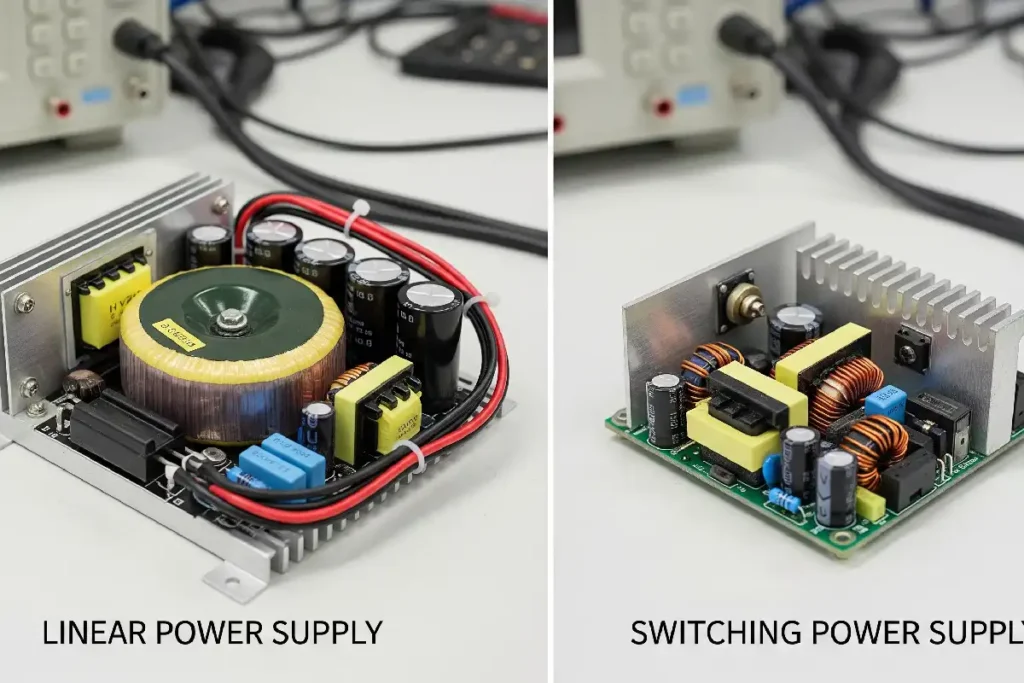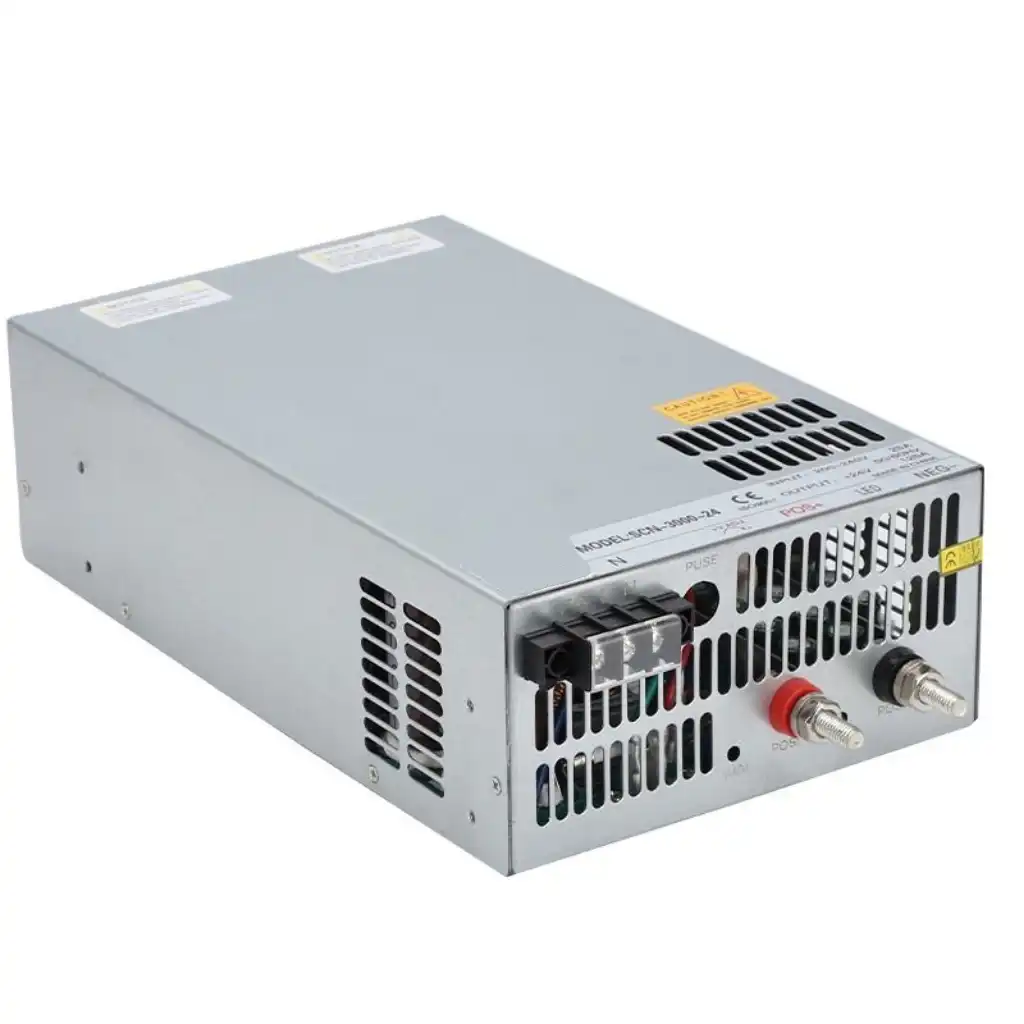You see linear power supply and switching power supply used in different ways. Audio systems, medical devices, and science tools need clean power. These use linear power supplies because they make less noise. Switching power supplies are better for small electronics, telecom systems, and LED lights. They work well because they save space and use energy better.
| Power Supply Type | Typical Applications | Key Advantages |
|---|---|---|
| Linear Power Supply | Audio, medical, lab equipment, test devices | Low noise, stable voltage |
| Switching Power Supply | Smartphones, data centers, industrial controls, LED lights | High efficiency, compact design |
Noise, how well it works, size, and price help you pick which power supply to use.
Key Takeaways
- Linear power supplies give clean and steady power. They are good for audio, medical, and precision instruments. These devices need low noise.
- Switching power supplies are small and save energy. They work well for portable electronics, industrial machines, and LED lighting.
- Linear power supplies are heavy and not very efficient. They give low noise and stable voltage. Switching power supplies are light and more efficient. But they make more noise.
- Use a linear power supply if your device needs quiet and precise power. Pick a switching power supply for better efficiency, smaller size, and more power.
- Always choose a power supply with 10-20% more wattage than your device needs. This helps keep things safe and makes equipment last longer.
Linear Power Supply Applications

Audio Equipment
Linear power supplies are used in fancy audio equipment. They make very little electrical noise. This is important for things like amplifiers and digital-to-analog converters. Low noise keeps sound clear and stops hum or distortion. These supplies also make less radio frequency and electromagnetic interference. Your audio system can play music with more detail and less background noise.
Tip: Many audio experts say sound is better with linear power supplies. They use them instead of switching types, especially for sensitive audio gear.
Linear power supplies are heavier and not as efficient. But they give clean power, so people pick them for serious audio use. Some new switching power supplies are better now. Still, most top brands trust linear designs to keep sound quality safe.
Test Instruments
Test instruments need power that is steady and clean. Examples are oscilloscopes, signal generators, and spectrum analyzers. Linear power supplies give these tools a steady voltage with almost no ripple or noise. This helps you get good measurements and results when testing circuits.
- Embedded systems testing and board debugging use linear power supplies for microcontrollers and FPGAs.
- RF and high-frequency signal testing need clean power to stop noise in signal paths.
- Automotive electronics testing needs correct voltage for sensors and control units.
- University labs use linear supplies so students can learn electronics without power mistakes.
Linear power supplies have a simple design. This makes them reliable. You can count on them to work well for a long time. That matters when you need exact results.
Medical Devices
Many medical devices use linear power supplies. Examples are X-ray machines, ultrasound systems, and ventilators. These devices need very low noise and steady voltage to work safely. Medical rules like IEC601 and UL60601 say power supplies must have strong isolation and low leakage currents. This keeps patients safe from electric shock and helps devices work right.
| Medical Device Type | Why Linear Power Supplies? |
|---|---|
| X-ray, Ultrasound | Low noise, steady voltage, patient safety |
| Dental, Ophthalmic | Very reliable, little interference |
| Surgical, Ventilator | Follows strict safety rules |
Home healthcare devices need special power supplies too. They must handle changes in home power and give extra insulation to protect patients. Linear power supplies help meet these tough rules and keep medical devices working well.
Precision Circuits
Precision circuits need power that is steady and has no electrical noise. Examples are measurement devices and science instruments. Linear power supplies are best for these jobs. They do not make high-frequency noise or ripple. This helps sensitive circuits, like high-resolution ADCs and DACs, work their best.
- Precision test systems use linear power supplies to stop mistakes in measurements.
- Science projects, like gravitational wave detectors, need linear supplies for steady, quiet power.
- Multichannel and bipolar circuits need low noise and steady voltage to work right.
Linear power supplies are used anywhere accuracy and clean power matter most. Efficiency or size is not as important. When you compare linear and switching power supplies, linear types win for noise-sensitive and precision jobs.
Switching Power Supply Applications

Consumer Electronics
Switching power supplies are in most electronics you use. Phones, laptops, tablets, and TVs all need them. They work well because they are small and save energy. These power supplies help devices stay cool. They also use less electricity, which saves money and helps the planet.
| Consumer Electronics Devices | Reason for Using Switching Power Supplies | Market Data Supporting Trend |
|---|---|---|
| Smartphones, Laptops, Televisions | Efficiency, compact size, ability to handle varying power demand | Switching mode power supply market made the most money in 2023 and will grow fastest soon |
| Laptops, Tablets, Home Entertainment Systems | More people bought these during COVID-19 for work and fun at home | The pandemic made more people use switching power supplies in these devices |
| Asia-Pacific Region | Biggest market because of lots of factories and electronics | Asia-Pacific made the most money in 2023 and will grow fastest |
| Market Size and Growth | – | The global switching power supply market was worth $12.7 billion in 2024 and may reach $16.4 billion by 2032 with a growth rate of 2.8% |
Switching power supplies are better than linear types for portable devices. You get longer battery life and less heat. Devices can be thinner and lighter because switching power supplies do not need big transformers. That is why you see them in almost every phone, tablet, and laptop.
Note: Switching power supplies help electronics last longer. They keep devices cool and use less energy.
Industrial Equipment
Switching power supplies are important for industrial equipment. You find them in motor drives, robots, PLCs, and communication tools. They also help data centers, renewable energy systems, and electric car charging stations.
- Motor drives use switching power supplies for speed and strength.
- Robots need them for steady power during work.
- PLCs need stable voltage for factory jobs.
- Data centers and telecom systems need protection from power surges.
- Renewable energy and smart grids use switching power supplies for good energy flow.
Switching power supplies save energy, often reaching 85-95%. You pay less for electricity and get less heat. Their small size fits tight spaces. Built-in protection keeps equipment safe from power surges. These supplies meet safety and performance rules around the world.
| Aspect | Explanation |
|---|---|
| High Efficiency | Switching power supplies often work at 70-90% efficiency, so less energy is lost and less heat is made. |
| Advanced Materials | Using GaN and SiC semiconductors lowers resistance and switching losses, making them more efficient. |
| Voltage Regulation & Noise | Better voltage control and less noise help industrial equipment work well and last longer. |
| Robust Design | Good cooling and protection features (overvoltage, overcurrent) help equipment last in tough places. |
| Smart Features | Real-time monitoring and predictive maintenance help stop problems and keep things running. |
| Compact & Modular Design | Small and flexible designs make it easy to use switching power supplies in many different machines and save energy. |
Switching power supplies help industrial systems work well, save energy, and stay safe. You get fewer problems and lower repair costs.
Computing Devices
Switching power supplies are used in computers, servers, and phone chargers. These devices need power supplies that work with many voltages and frequencies. Switching power supplies are cheap, efficient, and reliable.
New technology, like flyback controllers and GaN parts, makes switching power supplies even better. You get smaller, lighter, and more efficient power adapters. Your computer or charger stays cool and lasts longer.
| Feature | GaN Power Supplies | Silicon Power Supplies |
|---|---|---|
| Switching Speed | GaN switches up to 10 times faster, so it works better and makes less heat | Silicon switches slower because of its material |
| Heat Dissipation | GaN makes less heat, so you need smaller heat sinks | Silicon makes more heat, so you need bigger heat sinks |
| Size & Weight | GaN is smaller and lighter, so power adapters are tiny | Silicon is bigger and heavier |
| Power Efficiency | GaN can reach up to 96% efficiency, so less energy is wasted | Silicon is usually 80-90% efficient, so more energy is lost |
| Durability & Lifespan | GaN lasts longer because it does not get as hot | Silicon can wear out faster if it gets too hot |
Switching power supplies help computers and chargers run faster and cooler. You get longer battery life and do not need big fans. That is why most computers and chargers use switching power supplies instead of mixing linear and switching types.
LED Lighting
Switching power supplies are best for LED lighting systems. You see them in homes, offices, and outdoor signs. These power supplies give steady voltage and current, so LEDs shine bright and last longer.
| Advantage | Explanation |
|---|---|
| Smaller Size | High-frequency switching lets you use smaller transformers, so the power supply is smaller. |
| Higher Efficiency | Less energy is lost as heat, so switching power supplies are better than linear ones. |
| Cost-Effectiveness | Switching power supplies are cheaper for high power (400W+), because they are efficient and small. |
| Advanced Technology | Using GaN parts makes switching power supplies even more efficient and powerful. |
Switching power supplies keep LED lights cool and save energy. You get less flicker and better protection from electrical problems. Good cooling and design help LED systems last longer, even if high heat can hurt some parts. You pay less for electricity and get lights that work well.
Tip: If you want LED lights that save energy and last long, pick ones with switching power supplies.
Switching power supplies make LED lighting safer, more efficient, and more reliable than other types.
Linear Power Supply and Switching Power Supply: Key Differences
Efficiency and Heat
Linear power supplies waste more energy as heat. Switching power supplies save energy and stay cooler. If you use a 12V input to get 3.3V output, switching power supplies work much better. They can be over 90% efficient. Linear regulators only reach about 27.5% efficiency. This means switching power supplies lose less power and make less heat.
| Input Voltage | Output Voltage | Efficiency (Switching) | Efficiency (Linear) | Power Loss Reduction |
|---|---|---|---|---|
| 12V | 3.3V | >90% | <27.5% | 8x less loss |
When you need a power supply for big jobs, think about heat. Switching power supplies are good in hot places or where air does not move much. They help keep things safe and working well in factories, hospitals, and airplanes.
Noise and EMI
Noise and electromagnetic interference (EMI) are important for sensitive devices. Linear power supplies make very little noise. Their output noise is below 5 μV RMS. They block unwanted signals well. This is great for audio systems and medical devices. Switching power supplies make more noise, usually between 50-100 μV RMS. They also create EMI because they switch on and off quickly.
Modern switching power supplies use special designs to lower noise and EMI. You might see Silent Switcher® and EMI shielding. These help, but you still need extra filters for sensitive circuits. In hospitals, low noise keeps patients safe and comfortable. In audio gear, clean power gives better sound.
Size and Weight
Switching power supplies are much smaller and lighter than linear ones. They use high-frequency transformers, so they can be compact. Linear power supplies need big, heavy transformers.
| Power Supply Type | Height (mm) | Width (mm) | Depth (mm) | Weight (kg) |
|---|---|---|---|---|
| Linear | 124 | 84 | 325 | 3 |
| Switching | 124 | 35 | 128 | 0.5 |
Switching power supplies are good for phones, laptops, and portable tools. They fit in small spaces and are easy to carry. In factories, smaller supplies save space and make machines easier to build and fix.
Cost and Complexity
Linear power supplies have simple circuits. They cost less for small jobs. Switching power supplies are more complex, but they save money for big jobs because they are efficient and small.
| Feature | Linear Power Supply | Switching Power Supply |
|---|---|---|
| Circuit Complexity | Simple | Complex |
| Efficiency | Lower (30-60%) | Higher (70-95%) |
| Size and Weight | Larger, heavier | Smaller, lighter |
| Cost-Effectiveness | Best for <50 W | Best for >50 W |
| Output Noise | Low | Higher |
Switching power supplies are used in factories, telecom, and medical devices where you need reliable and efficient power. Linear power supplies are still used in labs and audio gear where clean power is most important.
Choosing the Right Power Supply
Application Needs
You need to think about what your device needs. Some devices must have clean power with low noise and steady voltage. Medical equipment, lab tools, and sensitive analog circuits need this kind of power. These devices cannot work well if there is too much electrical noise or ripple. Clean power helps keep signals clear and measurements correct.
Other devices need to be efficient, small, and handle lots of power. Portable electronics, control systems, and industrial machines use switching power supplies. These supplies save energy and fit in small spaces. They also cost less to run and do not make your device heavy or hot.
Tip: Pick a linear power supply if you need low noise and exact voltage. Choose a switching power supply if you want high efficiency and a small size.
Here is a simple guide to help you choose:
- Use linear power supplies for:
- Circuits that are sensitive to noise
- Medical and lab equipment
- Devices that need precise measurements
- Use switching power supplies for:
- Portable devices
- Devices that need lots of power or current
- Control systems and machines in factories
Selection Tips
You should pick the best power supply for your project. First, check how much voltage and current your device needs. Make sure the power supply can handle your device and has extra room for upgrades. Look for supplies that work efficiently to save energy and lower heat.
Use this table to compare important features:
| Selection Criteria | Linear Power Supply | Switching Power Supply |
|---|---|---|
| Efficiency | Low (20%-40%) | High (60%-90%) |
| Size and Weight | Large and heavy | Compact and lightweight |
| Noise and Ripple | Very low | Needs filtering |
| Transient Response | Fast and stable | May overshoot or ring |
| Application Suitability | Best for precision | Best for general use |
Check if the power supply has protection like overvoltage and short circuit features. Make sure it fits in your space and can be mounted easily. Always think about noise and heat, especially for sensitive devices.
Note: Linear power supplies are heavier and have quiet output. Switching power supplies are lighter and may need extra filters to lower noise.
You have learned where each power supply is used. Use linear power supplies for audio, medical, and precision tools. These need low noise and steady voltage. Use switching power supplies for electronics, LED lights, and factory machines. These need to be efficient and small.
Always pick a power supply with 10-20% more wattage than your device needs. This extra power helps keep your system safe if there are power spikes. It also helps your equipment last longer.
FAQ
What is the main difference between a linear and a switching power supply?
Linear power supplies have simple circuits and make less noise. Switching power supplies use fast parts that turn on and off quickly. They are smaller and work better at saving energy.
What applications need a linear power supply?
Linear power supplies are best for audio gear, medical tools, and test devices. These things need very steady voltage and almost no noise.
What makes switching power supplies better for portable devices?
Switching power supplies are small and light. They fit inside phones, tablets, and laptops. They also help batteries last longer by saving energy.
What problems can noise from a power supply cause?
Noise from a power supply can mess up sensitive circuits. You might hear buzzing in speakers or get wrong numbers on test tools.
What should you check before choosing a power supply?
Always check what voltage and current your device needs. Make sure the power supply can give a little extra power. Look for safety features like overvoltage protection.
See also
What Is a Switching Power Supply and How Does It Work
How to Choose the Right Switching Power Supply for Your Project
What Happens When a Switching Power Supply Converts AC Power to DC




